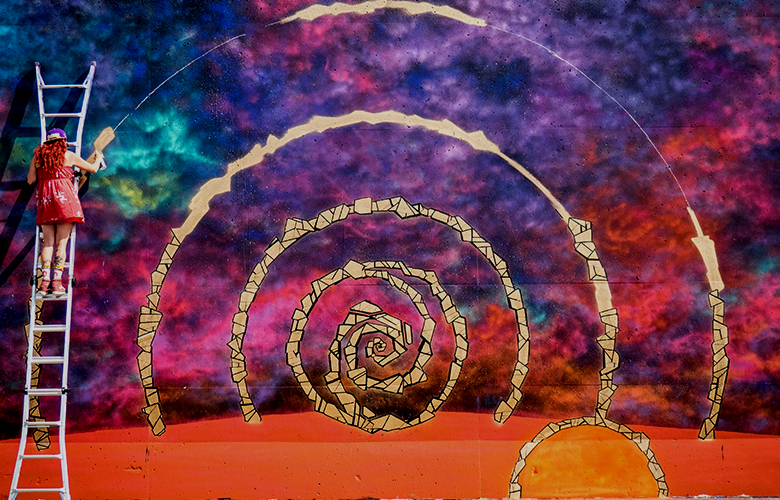
Original version in French below:
So, if I summarize, I open the bottle without pouring its contents everywhere. I’m prepared: latex gloves, properly cleaned mask and of course the right brush. I’ve read all of the precautions of usage before mixing the strange solution.
Pay close attention to the temperature of the room, my containers are all clean and well arranged on the table. The right doses for the final mixture! Ah yes, be precise to the gram as stipulated in the instructions. I think I have fully understood and am entirely prepared for this experience.
Let’s go, solution A in solution B, one portion for four of the other, without shaking, mix well without making bubbles. This pink marmalade seems homogeneous, all is well for the moment. Let rest and await the surprise in 24 hours. This could be a success or not. So many factors to consider for this new experiment and just as many constraints that determine the success of an artistic and creative process.
The multiple preparations at various stages are fraught with difficulties. Temperature, hydrometric, timing, percentages, the precision of the gesture, innumerable details to take into consideration. There are so many that one chance is obviously not enough.
I’ll use here the example of a little chemist sculptor trying the technique of silicone but the same requirements can apply to all areas of creation.
From writer to the choreographer, from the painter to the sound engineer, from the acrobat to the diver, we all have a multitude of traps awaiting us and all of us are so fortunate to be able to experiment.
To experiment means at the same time to fall, to graze, to be mistaken – and believe me, it’s necessary to be mistaken. This step is an essential step in the creation phase. To be wrong is the most effective way to learn and to acquire intelligence and to have the opportunity to progress.
Do you really believe that I learned the complex techniques of glass and resin in school? No, I learned them by burning my fingers and matting my hair with that crazy mixture. I wasted several litres of resin before finding the right formula. Do you believe that my English teacher would spend a trimester to teach me the name of every tool I use now daily? Of course not.
I often have doubted the pronunciation of a hammer, “hummer, Hommer, Hammur? ” I blushed so many times from shame of not understanding what my Australian or American colleagues were jabbering about. To be wrong is to gather solid experience in the field. That’s what forces us to think, make better choices and anticipate. It’s looking for options B, C, D, to find the solution Z. To be wrong is to push the door of ingenuity.
It is said that many inventions came into being by opportunity hidden in an unfortunate error. I’ll let you pick some of them yourself. You will understand that there is nothing wrong with being wrong. On the contrary.
If my memory serves me correctly, America was discovered by mistake, is it not so?
To be wrong is the chance to develop reasoning and curiosity. No teacher nor lecture will be able to give you these essential faculties to creation.
Err with a smile, everything is fine knowing you are in full creation. Err again and again without guilt or regret, you are simply awake. Err, your brain will thank you. Err because there is nothing more boring than people who know everything about everything. Err because there is nothing better than the discovery of oneself and your infinite creative abilities. And if your Ego makes your cheeks flush with anger or shame, tell yourself that you’re in full preparation of a work of art.
And if someone leads you to feel that your error is not acceptable, tell yourself that this same person does not have much of a mind.
Err boldly, you are a genius.
******
L’importance de se tromper.
Donc, si je résume, j’ouvre la bouteille sans en mettre de partout. Je prévois en latex, mon masque
préalablement nettoyé, le bon pinceau. Je lis les précautions
d’usage avant de mélanger l’étrange mixture. Faire bien attention à la température de la pièce, mes récipients sont propres et bien disposés sur la table. Les bonnes doses de mélange ! A oui, être précis au gramme prêt comme le stipule la notice. Je crois avoir tout compris et tout préparé pour cette expérience.
Allons-y, Solution A dans solution B, 1 pour 4, sans trembler, bien mélanger sans faire de bulles. La marmelade rose semble homogène, tout va bien pour le moment. Laissons reposer, nous aurons la surprise dans 24 heures. Peut être un succès ou pas.
Tant de facteurs à prendre en compte pour cette nouvelle expérience. Autant de contraintes qui déterminent le succès d’un processus artistique et créatif. Les multiples préparatifs et les diverses étapes sont semés d’embûches. La température, l’hydrométrie, le minutage, les pourcentages, la précision du geste, autant de détails à prendre en compte. Il y en à tellement qu’une seule chance ne suffit pas, c’est évident. Je prends ici l’exemple du petit chimiste sculpteur s’essayant au technique du silicone mais les mêmes exigences peuvent s’appliquer à tous les domaines de la création.
Du scénariste au chorégraphe, du peintre à l’ingénieur son, de l’acrobate au plongeur, nous avons tous une multitude de pièges qui nous attendent et tous avons la grande chance de pouvoir expérimenter.
Qui dit expérimenter dit chuter, s’écorcher, se tromper et croyez moi, il faut se tromper. Cette étape est un passage incontournable dans la phase de création. Se tromper est la manière la plus efficace d’apprendre, c’est de devenir intelligent, c’est avoir la chance de progresser.
Croyez vous vraiment que j’ai appris à l’école les techniques complexes de la fibre de verre et de la résine ? Non, je les ai appris en me brulant les doigts et en me collant les cheveux. J’ai gaspiller plusieurs litres de résine avant de trouver la bonne formule. Croyez vous que mon prof d’Anglais à passer un trimestre à m’ apprendre le nom de chaque outil que j’utilise aujourd’hui tous les jours. Bien sure que Non. J’ai souvent douté de la prononciation d’un marteau, « hummer, Hommer, Hammur ? » J’ai rougi tellement de fois de honte ne comprenant pas ce que baragouinaient mes collègues Australiens ou Américains.
Se tromper, c’est accumuler une solide expérience du terrain. C’est ce qui nous oblige à réfléchir, à faire de meilleurs choix et à anticiper. C’est chercher des options B, C D, jusqu’à trouver la solution Z. Se tromper c’est pousser la porte de l’ingéniosité.
On raconte que de très nombreuses inventions ont vu le jour par simple hasard suite à une erreur malencontreuse. Je vous laisse en chercher quelques unes vous même, vous comprendrez qu’il n’y à rien de mal à se tromper. Bien au contraire. Si ma mémoire est bonne, L’Amérique a été découverte par erreur, n’est ce pas ?
Se tromper est la chance de développer le raisonnement et la curiosité. Aucun professeur comme aucune leçon magistrale ne pourront vous donner ces facultés essentielles à la création.
Trompez-vous avec le sourire, tout va bien ,vous êtes en pleine création. Trompez vous encore et encore sans culpabilité, vous êtes en phase d’éveil tout simplement. Trompez les gants vous, votre cerveau vous remerciera. Trompez vous car il n’y a rien de plus ennuyeux que les gens qui savent tout sur tout. Trompez vous car il n’y a rien de mieux que la découverte de soit et de ses capacités de création infinies.
Et si votre Ego fait rougir vos joues de colère, ou de honte, dites vous que vous êtes en pleine préparation d’une œuvre d’art. Et si quelqu’un vous fait comprendre que votre erreur n’est pas acceptable, dites vous que cette même personne n’a pas beaucoup d’esprit et que son QI se rapproche difficilement du chiffre 2. Trompez vous, vous êtes un génie.
Props: I Dream Of The Perfect Workshop
Apps Set The Tone Of How We Work Today


Aurelie is in 1982 in Marseille, city open to the Mediterranean world, city of light and cultural diversity. She participated in major projects in France and abroad putting all her passion into her creative works. She worked with ‘Opera Garnier’ in Paris, the ‘Theatre Royal de la Monnaie’ in Brussels, the ‘Marseille Opera’ and the ‘Festival d’Art Lyrique’ in Aix-en-Provence. Since 2009, she has travelled across Asia, collaborating with Franco Dragone on “The House of Dancing Water” show, as well as being involved in other creations such as TABOO 1, TABOO 2, TABOO 4 in Macao. With the Hong Kong Theater Association, she designed “Le Père Noël est une Ordure”, “Les pas perdus”, "Musee Haut Musee Bas " and "Je Dance Toujours" sets. Alongside the singer Mouron, the choreographer Anne Tournie and Terry Truck Tournie Pianist, she realized the set and props creation for the show "Le cabaret des annees folles" at the "The French May 2013′′ Festival in Hong Kong. In 2013, she joined the UNIPLAN Luxury Event creative team in the Shanghai and Hong Kong as Performance and Show Production Expert. Working for “Louis Vuitton”, “Maserati” and “ Moet et Chandon” events. She is also involved in The Shanghai Pride organisation and collaborated with "Cirque le Soir" Club as creative consultant and special party organiser. In 2015, she worked with the Franco Dragone team on "The HAN Show" in Wuhan, "The LIDO" in Paris, "The Dai Show" in Xishuangbanna and other creations in Dubai, Moscou and China. In 2016, she joined the famous Worldwide company Balich for the Special Olympic Games Flag Handover between Austria and Abu Dhabi, designing the set and the large scale props. In 2017 She start a new collaboration with SOKOL Show and Wanda in Harbin China. In charge of the prop design and the props department during the conception, the creation and the artistic production; Aurelie has also started a collaboration with STUFISH designing and creating the "Holiday On Ice" show in 2018. She is designing and managing the massive stage for the new Stunt show produce by SEP production in Haikou China. 2018 is also a year where she illustrate some show concept and artistic project for SEP, WANDA and other concept in developement in CHINA and EUROPE. A great new collabortation in Marseille is starting with the new Concept Club BONBONNE, not as a DJ this time, but as interior designer and artistic consultant. Giving to the town a new trend and unique place for a new experience.
Read Full Profile© 2021 TheatreArtLife. All rights reserved.

Thank you so much for reading, but you have now reached your free article limit for this month.
Our contributors are currently writing more articles for you to enjoy.
To keep reading, all you have to do is become a subscriber and then you can read unlimited articles anytime.
Your investment will help us continue to ignite connections across the globe in live entertainment and build this community for industry professionals.